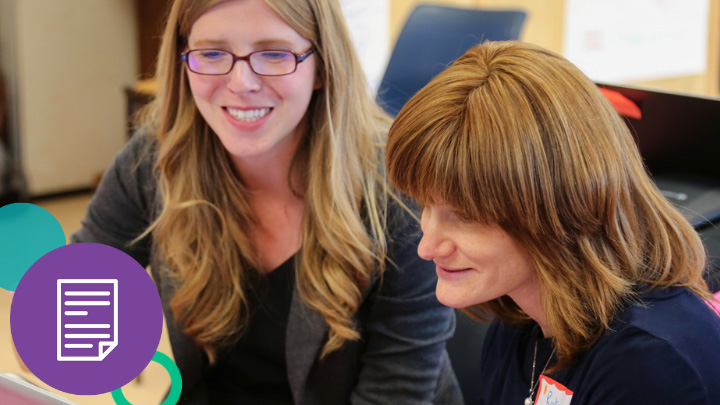Leadership in the midst of a global pandemic is no easy task. From research-backed instructional practices to meeting the needs of all learners and educators, this role can be overwhelming. As a BetterLesson instructional coach, I support leaders all over the United States. I’ve learned that coaching can be beneficial for all types of leaders, regardless of their experience level, expertise, school demographics, and school district.
Often, I find leaders are reticent when it comes to leadership coaching. With so much to do, leaders want to ensure that every minute leads to tangible improvements in their work and results for students. They may also have years of experience and (rightfully) have high standards for who they work with. Acknowledging that reality is vital. Through bi-weekly check-ins, BetterLesson coaches support school and district leaders to clarify their vision and create a plan to achieve it.
Establishing a Vision Statement
I met Sarah* in September. This was her 4th year as an elementary principal, and she was excited to start coaching because she needed accountability and a thought partner. Sarah had many years of experience as a classroom teacher and instructional coach but wanted to improve her school’s instructional practices. During our first meeting, Sarah shared her goals with me: “to develop, define, and communicate a rigorous instructional vision to staff members and align teacher feedback and collaboration to the instructional vision.” As her coach, I was able to support her in several ways:
- Probe her thinking to clarify her vision: To help leaders like Sarah focus their vision, I ask questions such as, “What’s going well? Why is this going well? What are some challenges that you are having? Why is this a challenge?” Though she may know these issues very well in her head, providing a space for her to articulate them clarifies her thinking. Asking Sarah questions about specific grade levels, student achievement, and collaboration gave her an opportunity to reflect. As a result of this refined goal, Sarah created additional resources for her teachers such as lesson planning templates and exit tickets to collect data from each grade level.
- Narrow the focus: Many leaders have ambitious goals. Yet too many goals or goals that are too broad may become hard to achieve. As a coach, I ask the hard questions to help leaders narrow their focus to ones that are both impactful and achievable. For example, if a leader started off with this goal statement: “My vision for the 2020-2021 school year is to improve writing instruction within my school,” we may start with identifying the current successes and challenges with writing instruction in each grade level, and then narrowing in on what exactly needs to change.
Taking Steps to Achieve the Vision and Promote School-Wide Success
Elizabeth* is a leader in a Title 1 Kindergarten through 8th-grade school. She wants her teachers and students to succeed, but it can be quite a challenge in this remote learning environment. During our first meeting, Elizabeth shared her vision: “to use teacher observations in the virtual setting to foster student-centered instructional practices and promote growth for all teachers.” Elizabeth’s observation load is considerable — she is responsible for 50 classroom observations, providing meaningful feedback, and meeting with some teachers to have one-on-one conversations about their instructional practices. We worked together to shape that goal and make plans to make it a reality. Some helpful strategies that we use are:
- Frequent reflection: Leaders will spend time reflecting to refine current practices as they take steps to achieve their vision. Using the try-measure-learn method, they gain a deeper understanding of the strengths and gaps within their school. This way I have the opportunity to collaborate, reflect, and refine together with the leaders I coach to move them toward success.
- A focus on action planning: Debriefing and setting next steps occurs during each coaching session. Throughout the coaching cycle, I give the leaders I coach tasks that will help them work toward achieving their vision. In our meetings, we will discuss the strengths and gaps of the tasks.
Bi-Weekly Meetings to Foster Growth and Accountability
Tara* is an experienced leader who was placed in a new virtual school this past September. During our first meeting, Tara shared her reality with me, “Lauren, I need help with the bare bones. We are just getting started, and I just got hired a week ago.” Tara was the only principal at her school, so the bi-weekly meetings were helpful and productive for several reasons:
- Consistent planning time: Leadership coaching fosters a common planning time. With bi-weekly meetings, leaders are given dedicated time to discuss new ideas, strategies, and instructional practices and seek authentic feedback.
- Professional growth: A principal’s core role is to promote teacher and student growth within the building. Leadership coaching allows the principal to grow, reflect, and refine their practices. I’ve worked with leaders that realize that they have certain strengths and gaps throughout the coaching cycle, and as their coach, I work with them to close the gaps and celebrate their strengths.
- An empathetic, expert ear: When leaders meet with their coaches, the coach practices active listening. This is beneficial because leaders may spend a majority of their time observing and listening to their teachers and students. A coach provides them with that same care and attention to their own needs.
There may be leaders who have doubts about coaching. As a former assistant principal, I understand how challenging it can be to observe teachers and students, attend conferences and seminars, and make sure the school is running smoothly. That is a shared reality of leadership, but I know coaching has many benefits to make these challenges easier for school leaders. From creating a vision and taking the next steps to establishing thought-partners and common planning times, leadership coaching can help all school and district leaders regardless of their experience level, expertise, school demographics, and school district.







